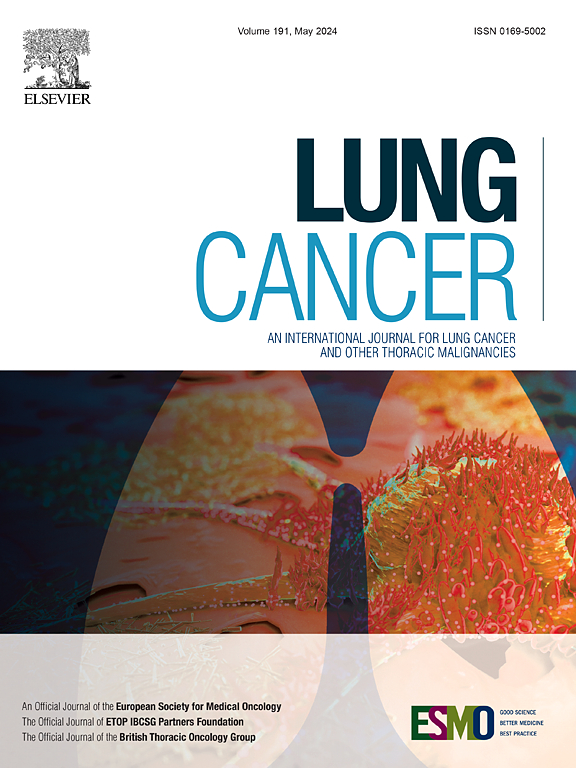未经治疗的晚期非小细胞肺癌患者肺免疫预后指数的验证:IMpower 130、131和150试验的事后分析
IF 4.5
2区 医学
Q1 ONCOLOGY
引用次数: 0
摘要
lipi与晚期非小细胞肺癌的免疫治疗(IT)结果密切相关。前期化疗(CT) + IT联合的数据有限。我们的目的是研究它在一线CT +/- IT +/-抗血管生成中的预后价值。方法回顾性分析IMpower150、IMpower131和IMpower130(国际3期多中心研究)中接受一线CT +/- atezolizumab和/或贝伐单抗治疗的野生型EGFR/ALK aNSCLC患者的数据。LIPI是根据中性粒细胞/(白细胞-中性粒细胞)(dNLR)比率和血清LDH: good (dNLR <;3、LDH <;ULN),中等(dNLR≥3或LDH≥ULN)和差(dNLR≥3和LDH≥ULN)。结果2540例患者中,LIPI良好者占48.6%,中等者占40.8%,较差者占10.6%。在整个队列中,LIPI与治疗结果(PFS, OS)显著相关(p <;0.001),每个治疗队列(p <;0.001)。在调整了年龄、吸烟状况、转移部位数量、脑或肝受累情况和运动状态后,LIPI仍然是PFS和OS的独立预后因素。在LIPI良好组(n = 1235)中,CT + IT + AA治疗的患者PFS更长(中位[m] PFS 11.3 vs. <;7.6个月的其他方案,p <;0.001), OS的趋势(mOS 26.1 vs 20.7个月,p = 0.08)。与化疗相比,LIPI差组没有方案显示出显著的PFS益处。LIPI-good + PD-L1≥50% (n = 105)的患者反应时间较长(mPFS为11.1个月,未达到最大生存期)。结论在aNSCLC前瞻性试验中,无论治疗方案如何,slipi都是PFS和OS的预后因素。LIPI差的患者没有从联合治疗中获益。LIPI联合PD-L1可改善前期治疗选择。本文章由计算机程序翻译,如有差异,请以英文原文为准。
Validation of the Lung Immune Prognostic Index in patients with untreated advanced non-small cell lung cancer: Post hoc analysis of the IMpower 130, 131 and 150 trials
Introduction
LIPI has been strongly correlated with immunotherapy (IT) outcomes in advanced NSCLC. Limited data is available for upfront chemotherapy (CT) + IT combinations. We aimed to study its prognostic value in 1st-line CT +/- IT +/- antiangiogenics.
Methods
Data from patients with wild-type EGFR/ALK aNSCLC included in IMpower150, IMpower131, and IMpower130 (international phase 3 multicenter studies) treated with 1st-line CT +/- atezolizumab and/or bevacizumab were retrospectively analysed. LIPI was calculated based on the neutrophil/(leucocytes-neutrophils) (dNLR) ratio and serum LDH: good (dNLR < 3 and LDH < ULN), intermediate (dNLR ≥ 3 or LDH ≥ ULN) and poor (dNLR ≥ 3 and LDH ≥ ULN).
Results
Out of 2540 patients, 48.6 % were LIPI good, 40.8 % intermediate and 10.6 % poor. LIPI was significantly associated with treatment outcomes (PFS, OS) in the overall cohort (p < 0.001) and in each treatment cohort (all p < 0.001). After adjustment for age, smoking status, number of metastatic sites, brain or liver involvement and performance status, LIPI remained an independent prognostic factor for PFS and OS. In the LIPI good group (n = 1235), longer PFS was observed in patients treated with CT + IT + AA (median [m] PFS 11.3 vs. < 7.6 months with other regimens, p < 0.001), with a trend for OS (mOS 26.1 vs 20.7 months, p = 0.08). No regimen demonstrated significant PFS benefit in the LIPI poor group compared to chemotherapy. LIPI-good + PD-L1 ≥ 50 % (n = 105) showed long responses (mPFS of 11.1 months, mOS not reached).
Conclusions
LIPI was prognostic for PFS and OS in prospective trials in aNSCLC, regardless of the treatment regimen. LIPI poor patients derived no benefit from combination treatment. LIPI combined to PD-L1 may improve the upfront treatment selection.
求助全文
通过发布文献求助,成功后即可免费获取论文全文。
去求助
来源期刊

Lung Cancer
医学-呼吸系统
CiteScore
9.40
自引率
3.80%
发文量
407
审稿时长
25 days
期刊介绍:
Lung Cancer is an international publication covering the clinical, translational and basic science of malignancies of the lung and chest region.Original research articles, early reports, review articles, editorials and correspondence covering the prevention, epidemiology and etiology, basic biology, pathology, clinical assessment, surgery, chemotherapy, radiotherapy, combined treatment modalities, other treatment modalities and outcomes of lung cancer are welcome.
 求助内容:
求助内容: 应助结果提醒方式:
应助结果提醒方式:


